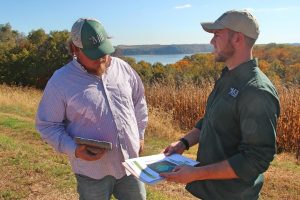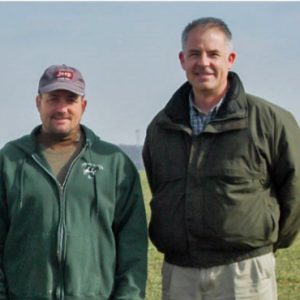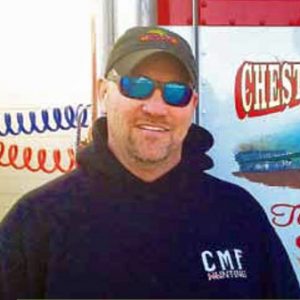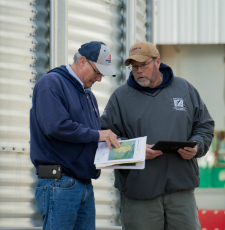4R Advocates
Three Mid-Atlantic farmers and their ag service providers have been highlighted through the national 4R Advocate Program- Mike Kurek (with Tim Hushon, The Mill), Jonathan Quinn (with Kenny Glenn from Southern States), Sean Jones (with Mike Twining from Willard Agriservice), and Temple Rhodes.
Mike Kurek was selected as a 4R Advocate in 2020, with Tim Hushon as his agronomist from The Mill.
Mike lives in Pennsylvania and is the first 4R Advocate selected for the state. With his wife, Mike manages 315 acres in Delta, producing corn, soybeans, peaches, apples, and pumpkins. The farm is open to the public as a pick-your-own operation and farm stand.

The couple values land preservation for their three children, and 4R practices help make it possible. The farm is four miles from the Conowingo Dam and sustainable business practices are a huge investment. 4R practices began in the orchard! After improvements in yield were noticed through a spoon-feeding foliar fertilizer application system and minimized disturbance of soil, Mike decided to take the next step forward. Today Mike, utilizes regular tissue sampling to assess nutrient needs and applies 100% of his nutrients through foliar application. Tim Hushon began advising Mike in 2012, opening the gate for the 4Rs to be implemented. Mike and Tim enjoy the challenge of maximizing yield through the 4R Nutrient Stewardship Program.
Jonathan Quinn was selected as a 4R Advocate in 2019, with Kenny Glenn as his advisor from Southern States Cooperative.
It’s no surprise that one who leads a fifth-generation farm might also be an early adopter. Jonathan Quinn was one of the first in the Delmarva region to invest in a yield monitor. He also incorporated the 4Rs before they were so named. It comes naturally. His father was conducting annual soil tests in the 1960s. They still do. Little Bohemia Creek Farms now covers 2,350 acres in the Chesapeake Bay Watershed and includes corn, soybeans, wheat, barley, and spinach, as well as a custom farming business.
Though Maryland law requires nutrient management plans be filed for every acre on the farm, they’re not new to Quinn. He and his crop advisor, Kenny Glenn with Southern States Cooperative in Middletown, Delaware, have used 4R strategies in the plans since the beginning. In fact, they’ve worked together for 20 years to continually improve the farm and community.
“Even when we voluntarily compiled nutrient management plans, we found we didn’t need all the nutrients we were applying,” Quinn says. “We’ve gotten better since.”
In addition to 4R practices, technology helps. GPS, autosteer, the yield monitor, a 16-row, variable-rate planter, 30’ air seeder, and variable-rate sprayer are supplemented by satellite field imagery and soil maps.
Pre-sidedress nitrate tests, tissue samples, and fall nitrate tests help guide in-season nitrogen applications. UAN is variable-rate injected, even in sidedress applications, and Avail phosphorous enhancer and NutrisphereN help ensure they’re available to the crop when needed. Cover crops help retain nutrients through winter.
It pays off. Corn and soybean yields are up five to 10 percent, while nutrient application remains optimal for soil and crop health. If these 4R practices work for the Chesapeake Bay Watershed, they’ll work anywhere.
Best Practice Management:
- Annual grid and soil sampling guide nutrient management plan to focus only on what nutrients are needed.
- Nutrient management plan determines how much N, P, and K are needed.
- Pre-sidedress and fall nitrate tests help determine in-season nitrogen applications.
- Injected UAN reduces volatilization.
- Variable-rate nutrient application ensures crops get the right amount of nutrients.
- GPS-precision nutrient applications helps soils that need additional nutrients get the right ones.
- Variable-rate sprayer delivers the exact amount of product needed.
- Cover crops retain nutrients.
- Conservation practices include cover crops, no-till, grassed waterways, riparian buffers, wildlife habitat, an agricultural chemical handling facility, and a manure storage building.
Sean Jones was selected as a 4R Advocate in 2015.
What Sean Says About the 4Rs:
“A combination scrape/flush flume system removes manure from barns into a sand separation system. A slope screen separator removes large solids for application in accordance with our nutrient plan and the right place practice of the 4Rs. Low solid material is applied via pivot irrigation at the right time. Using irrigation, we capitalize on nutrients and the 4Rs.”
What Mike Says About the 4Rs:
“We pulled more than 30 manure analyses to ensure our decisions were as accurate as they could be. These helped us be certain we were applying nutrients at the right rate. All pivot systems can fertigate based on plant tissue analysis and our nitrogen modeling tool, guided by the 4R principles.”
 Temple Rhodes was selected as a 4R Advocate in 2012.
Temple Rhodes was selected as a 4R Advocate in 2012.
Temple Rhodes, Chestnut Manor Farm, Centreville, Md., 2,200-acre corn, soybean and beef producer nominated by Willard Agri-Service, Maryland. On the eastern shore of Chesapeake Bay, the Rhodes family takes a proactive approach to nutrient management. A strip-till system applies all fertilizer beneath the soil surface, tissue sampling assesses crop need and rates reflect site-specific data. Temple works with Willard Agri-Service’s Allan Spray to make cropping decisions that result in higher nutrient use efficiency and increased farm profitability.
What Allen says about the 4Rs:
“The 4R program is central to what we do as an ag retailer for our customers. Helping our customers maximize nutrient use efficiency is a critical part of both the economic and ecologic well-being of our farming environment. The 4R philosophy is part of all the recommendations we make and also drives our thought process on formulation of the products we sell.”
What Temple says about the 4Rs:
“Many of my farms border the Chesapeake Bay. As I strive to grow and improve my farming operation, the practices of the 4R program are helping me to get higher yields and also be a good steward of the environment”.
You can read their full stories and those of other National 4R Advocates at the 4R Nutrient Stewardship website at: http://www.nutrientstewardship.com/advocates/
